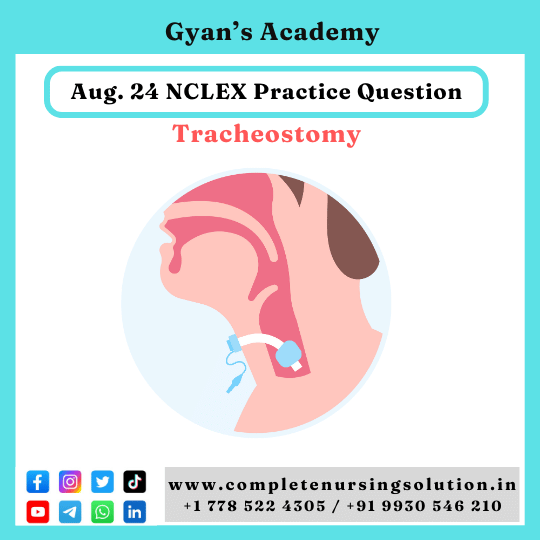A tracheostomy tube, an artificial airway inserted into the trachea through the neck, may be secured with sutures or tracheostomy ties. Accidental dislodgment of a tracheostomy tube is a medical emergency often resulting in respiratory distress from closure of the stoma and airway loss.
If accidental dislodgment of mature tracheostomies (ie, >7 days after insertion) occurs where the tract is well formed, the nurse should attempt to open the airway by inserting a curved hemostat to maintain stoma patency and insert a new tracheostomy tube with an obturator (Option 3).
(Option 1) Application of supplemental oxygen via nonrebreather face mask may not resolve respiratory distress because air can escape from the stoma.
(Option 2) Covering the stoma with a sterile, occlusive dressing (eg, petroleum gauze, foam tape) and ventilating the lungs with a bag-valve mask over the nose/mouth may be necessary if the tube cannot be reinserted or the stoma is immature. Dry gauze is porous and does not adequately seal the stoma for ventilation.
(Option 4) Tracheal suctioning may be necessary once the airway is resecured. However, suctioning prior to establishing an airway does not improve ventilation and may further reduce the oxygen supply.
Educational objective: Accidental dislodgment of a tracheostomy tube is a medical emergency. With a mature tracheostomy, an attempt to insert a new tracheostomy tube with the bedside obturator is indicated. If a tube cannot be reinserted, the stoma is covered with a sterile, occlusive dressing. Ventilation is provided with a bag-valve mask over the nose/mouth.
A tracheostomy tube, an artificial airway inserted into the trachea through the neck, may be secured with sutures or tracheostomy ties. Accidental dislodgment of a tracheostomy tube is a medical emergency often resulting in respiratory distress from closure of the stoma and airway loss.
If accidental dislodgment of mature tracheostomies (ie, >7 days after insertion) occurs where the tract is well formed, the nurse should attempt to open the airway by inserting a curved hemostat to maintain stoma patency and insert a new tracheostomy tube with an obturator (Option 3).
(Option 1) Application of supplemental oxygen via nonrebreather face mask may not resolve respiratory distress because air can escape from the stoma.
(Option 2) Covering the stoma with a sterile, occlusive dressing (eg, petroleum gauze, foam tape) and ventilating the lungs with a bag-valve mask over the nose/mouth may be necessary if the tube cannot be reinserted or the stoma is immature. Dry gauze is porous and does not adequately seal the stoma for ventilation.
(Option 4) Tracheal suctioning may be necessary once the airway is resecured. However, suctioning prior to establishing an airway does not improve ventilation and may further reduce the oxygen supply.
Educational objective: Accidental dislodgment of a tracheostomy tube is a medical emergency. With a mature tracheostomy, an attempt to insert a new tracheostomy tube with the bedside obturator is indicated. If a tube cannot be reinserted, the stoma is covered with a sterile, occlusive dressing. Ventilation is provided with a bag-valve mask over the nose/mouth.




More posts like this would make the online elbow-room more useful.
This website exceedingly has all of the bumf and facts I needed to this subject and didn’t positive who to ask.
I am in point of fact delighted to glance at this blog posts which consists of tons of worthwhile facts, thanks towards providing such data.
Đến với J88, bạn sẽ được trải nghiệm dịch vụ cá cược chuyên nghiệp cùng hàng ngàn sự kiện khuyến mãi độc quyền.
Ich nutze am liebsten Sportwettenanbieter, die auch eine Casino
Lizenz haben. Es gibt Wettanbieter Lizenzen aus Malta und Curaçao,
die genauso vergeben werden wie Casino Lizenzen. Ja,
im Prinzip gilt alles hier Geschriebene auch für Sportwettenanbieter.
Im Juni 2022 ging dann das erste neue deutsche Online Spielothek Jackpotpiraten an den Start.
Erst 2022 gingen dann die ersten Online Spielotheken mit deutscher Lizenz an den Start.
10 Jahre später sollte die neue deutsche Regulierung greifen, allerdings klappte
die Umsetzung zunächst nicht.
Als neuer Spieler wirst du vom Gxmble Casino ohne deutsche Lizenz
mit einem saftigen Willkommenspaket von insgesamt
2.500 € begrüßt. Das Live-Angebot bietet dir als Spieler
insgesamt über 300 Live-Casino-Spiele. Im Test der Casinos ohne deutsche Lizenz haben uns
die 5-fachen Umsatzbedingungen besonders gefallen.
Dabei sind Freispiele ideal, um neue Slots zu testen, ohne Dein eigenes Geld dabei zu
verwenden. Ob im Rahmen eines Willkommensbonus oder als tägliche oder wöchentliche Reload-Aktion. Hier erhältst Du Bonusguthaben oder Freispiele ganz ohne Geld
einzahlen zu müssen.
References:
https://online-spielhallen.de/1go-casino-freispiele-ihr-schlussel-zu-kostenlosem-spielspas-und-gewinnen/
Discover the secrets of 999,999,999,999,999,999,999 with our full breakdown of its prime
factors, divisors, and mathematical properties…
This visualization shows the relative proportions of its 7 prime factors (outer circle), plus the relationship between these
and its 256 divisors. You could say that a number is made or ‘composed’ of its prime factors.
Its factors, divisors, and base properties can show some
interesting behavior.
What makes 999,999,999,999,999,999,999 an interesting number from a mathematical point of
view? Just find the currency and get spelling for it.
By using this site you accept our terms and conditions
including our privacy and cookie, copyright and permissions policies.
Every whole number greater than 1 is formed from at least
one prime factor. Below you’ll find its key properties, along with some statistical info, fun facts and trivia.
Here we have made a list of the currency names you would need
to write spellings in order to deposit money against
your currency cheques, DD, loan payments or more.
Prime factors of a number are the prime numbers that multiply
together to form that number. Like all numbers, it has a distinctive
mathematical structure.
References:
https://blackcoin.co/the-star-gold-coast-ultimate-casino-guide/
Our Casino Rocket promo code 2026 works in all accepted countries,
including AU, CA, NZ and ZA. So read carefully the instructions of the chosen deals to know beforehand the size of playthrough and other conditions.
So, as with most bonus incentives, the first step is to pursue research
and read T&Cs. A person chooses between craps, roulette,
keno, blackjack, pokies and other games except where otherwise
stated.
RocketPlay casino has around 3,000 games from more than 50 game providers.
They have one of the most diverse offers of crypto games!
There could be more ongoing weekly free spins (the best casinos have at least 200).
They could offer more ongoing in-house promotions
(the best casinos offer at least 8 every week).
There could be more welcome free spins (the best casinos offer at
least 200).
Your VIP status advances as you accumulate more points through gameplay.
Upon signing up, every player automatically becomes a member of this program, which consists
of 10 distinct levels.
References:
https://blackcoin.co/luck-nation-casino-real-money-pokies-australia/